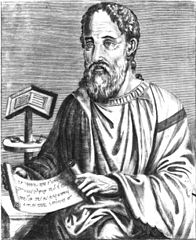
An Ecclesiastical History To The 20th Year Of The Reign Of Constantine by Eusebius
CHAPTER X
THE HIGH PRIESTS OF THE JEWS, UNDER WHOM CHRIST PROMULGATED HIS DOCTRINES
IT was about the fifteenth year of the reign of Tiberius, according to the Evangelist, in the fourth year of Pilate’s procuratorship, Herod, Lysanias, and Philip, as tetrarchs, holding the government of the rest of Judea, when our Lord and Saviour Jesus Christ was in his thirtieth year, that he came to the baptism of John, and then began to promulgate his gospel. The holy Scriptures, moreover, relate that he passed the whole time of his public ministry under the high priests Annas and Caiaphas; intimating that during the years of their priesthood, the whole time of his ministry was terminated. For, beginning with the pontificate of Annas, and continuing after that of Caiaphas, the whole of this interval does not even give us four years. The rites, indeed, of the law, having been already abolished since that period, with it were also annulled the privileges of the priesthood, viz., of continuing it for life, and of hereditary descent. And under the Roman governors, different persons at different times were appointed as high priests, who did not continue in office more than a year. Josephus, indeed, relates that there were four high priests in succession from Annas to Caiaphas. Thus, in his book of Antiquities, he writes in the following manner: “Valerius Gratus, having put a period to the priesthood of Annas, promoted Ishmael, the son of Baphi, to the office; and, removing him also, not long after, he appointed Eleazar, the son of Annas, who had been high priest, to the office. After the lapse of a year, removing also him, he transfers the priesthood to Simon, the son of Camithus. And he, also, did not continue to hold the honour longer than a year, when he was succeeded by Josephus, surnamed Caiaphas.” Hence, the whole time of oar Saviour’s ministry is proved not to embrace four entire years, there being four high priests for four years, from Annas to the appointment of Caiaphas, each of which held the office a year respectively. Caiaphas, indeed, is justly shown, by the gospel narrative, to have been high priest in that year in which our Saviour’s sufferings were finished. With which observation, the time of Christ’s ministry is also proved to agree. Our Lord and Saviour Jesus Christ, not very long after the commencement of his public ministry, elected the twelve, whom he called Apostles, by way of eminence over the rest of his disciples. He also appointed seventy others beside these, whom he sent, two and two, before him into every place and city whither he himself was about to go.
Copyright ©1999-2023 Wildfire Fellowship, Inc all rights reserved

 Keep Site Running
Keep Site Running